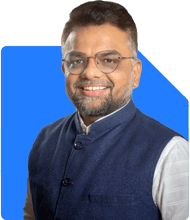Vivek Shah | Answer |Ask -Follow
Financial Planner - Answered on Mar 08, 2023
Shah founded Finrise, a financial planning and wealth management firm, in 2011. He believes that equity investment is the only way to generate long term wealth.
He has an MBA in finance, a degree in chartered accountancy and is a registered life planner from Kinder Institute of Life Planning, USA.... more

Hello, I am 37 Years old and my name is Vivek. I want to generate around 5 crores in the next 15 years for my child's education and a new home. Please suggest the SIP amount and the funds that will help me achieve this target?
Glad to know that our names are same. Secondly, you also have your financial goals mentioned which is really a good sign to more forward with structured investment and tracking of your investments.
Looking at your requirement, please find the below solution from my side.
1) I am supposing that both your goals are maturing in the same year after 15 years.
2) I am assuming the returns of 12% and i am assuming that the figure which you have mentioned is already inflation adjusted which is Rs 5 crore.
Based on this information and assumption, you should have SIP of Rs 1,07,000.
I would recommend to invest in following funds:
1) large & Midcap Fund- 25%
2) Midcap Fund- 25%
3) Flexicap Fund- 25%
4) First Small Cap Fund- 13%
5) Second Small Cap Fund- 12%
You can select any good fund in these categories and stick to it for long term until and unless there are not any major changes to the fund.
Remember one thing, investment is not about selecting the best funds but 95% success in fulfilling your financial goal is managing your emotions and behavior in your journey of wealth creation.
I hope this will help you... Happy Investing...
Disclaimer: This information is only for educational purpose and it should not be taken as buy or sell recommendation. I may or may not have any position in these mutual funds or stocks while answering this question.
You may like to see similar questions and answers below
Vivek Lala |323 Answers |Ask -Follow
Tax, MF Expert - Answered on May 18, 2023
Ramalingam Kalirajan |10902 Answers |Ask -Follow
Mutual Funds, Financial Planning Expert - Answered on Aug 30, 2023
Ramalingam Kalirajan |10902 Answers |Ask -Follow
Mutual Funds, Financial Planning Expert - Answered on Apr 30, 2024
Ramalingam Kalirajan |10902 Answers |Ask -Follow
Mutual Funds, Financial Planning Expert - Answered on Apr 23, 2024
Ramalingam Kalirajan |10902 Answers |Ask -Follow
Mutual Funds, Financial Planning Expert - Answered on Jun 11, 2024
Samraat Jadhav |2514 Answers |Ask -Follow
Stock Market Expert - Answered on Dec 18, 2025
Reetika Sharma |432 Answers |Ask -Follow
Financial Planner, MF and Insurance Expert - Answered on Dec 18, 2025
Reetika Sharma |432 Answers |Ask -Follow
Financial Planner, MF and Insurance Expert - Answered on Dec 18, 2025
Reetika Sharma |432 Answers |Ask -Follow
Financial Planner, MF and Insurance Expert - Answered on Dec 18, 2025
Samraat Jadhav |2514 Answers |Ask -Follow
Stock Market Expert - Answered on Dec 18, 2025

Kanchan Rai |648 Answers |Ask -Follow
Relationships Expert, Mind Coach - Answered on Dec 18, 2025
Kanchan Rai |648 Answers |Ask -Follow
Relationships Expert, Mind Coach - Answered on Dec 18, 2025
Anu Krishna |1754 Answers |Ask -Follow
Relationships Expert, Mind Coach - Answered on Dec 18, 2025
Anu Krishna |1754 Answers |Ask -Follow
Relationships Expert, Mind Coach - Answered on Dec 18, 2025
Anu Krishna |1754 Answers |Ask -Follow
Relationships Expert, Mind Coach - Answered on Dec 18, 2025

























